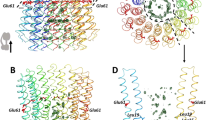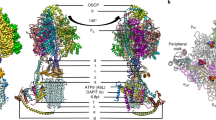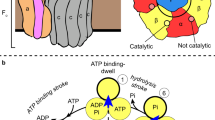Abstract
The ATP synthases of bacteria, mitochondria and chloroplasts, which use the energy of a transmembrane proton gradient to power the synthesis of ATP, consist of an integral membrane component F0—thought to contain a proton channel—and a catalytic component, F1. To help investigate the way F0 and F1 are coupled, we have sequenced the b-subunit of the Escherichia coli F0, which seems to be the counterpart of a thermophilic bacteria F0 summit thought to be essential for F1 binding1. We report here that its sequence is remarkable, being hydrophobic around the N-terminus and highly charged in the remainder. We propose that the N-terminal segment lies in the membrane and the rest outside. The extramembranous section contains two adjacent stretches of 31 amino acids where the sequence is very similar: in the second of these stretches there is further internal homology. These duplicated stretches of the polypeptide probably fold into two α-helices which have many common features able to make contact with F1 subuits. Thus protein b occupies a central position in the enzyme, where it may be involved in proton translocation. It is possibly also important in biosynthetic assembly.
This is a preview of subscription content, access via your institution
Access options
Subscribe to this journal
Receive 51 print issues and online access
$199.00 per year
only $3.90 per issue
Buy this article
- Purchase on Springer Link
- Instant access to full article PDF
Prices may be subject to local taxes which are calculated during checkout
Similar content being viewed by others
References
Friedl, P., Bienhaus, G., Hoppe, J. & Schairer, H. U. Proc. natn. Acad. Sci. U.S.A. 78, 6643–6646 (1981).
Nielsen, J., Hansen, F. G., Hoppe, J., Friedl, P. & Meyenberg, K. Molec. gen. Genet. 184, 33–39 (1981).
Engleman, D. M., Hendersen, R., McLachlan, A. D. & Wallace, B. A. Proc. natn. Acad. Sci. U.S.A. 77, 2023–2027 (1980).
Chothia, C., Levitt, M. & Richardson, D. J. molec. Biol. 145, 215–250 (1981).
Janin, J. & Chothia, C. J. molec. Biol. 143, 95–128 (1980).
Futai, M., Sternweis, P. C. & Heppel, L. A. Proc. natn. Acad. Sci. U.S.A. 71, 2725–2729 (1974).
Smith, J. B. & Sternweis, P. C. Biochemistry 16, 306–311 (1977).
Yoshida, M., Okamoto, H., Sone, N., Hirata, H. & Kagawa, Y. Proc. natn. Acad. Sci. U.S.A. 74, 936–940 (1977).
Sternweis, P. C. J. biol. Chem. 253, 3123–3128 (1978).
Takeda, K. et al. J. Biochem., Tokyo 91, 695–701 (1982).
Yoshida, M., Sone, N., Hirata, H., Kagawa, Y. & Ui, N. J. biol. Chem. 254, 9525–9533 (1979).
Bragg, P. D. & Hou, C. Archs Biochem. Biophys. 167, 311–321 (1975).
Fillingame, R. H. Curr. Topics Bioenerget. 11, 35–106 (1981).
Sone, N., Yoshida, M., Hirata, H. & Kagawa, Y. Proc. natn. Acad. Sci. U.S.A. 75, 4219–4223 (1978).
Cox, G. B. et al. J. Bact. 148, 30–42 (1981).
Gay, N. J. & Walker, J. E. Nucleic Acids Res. 9, 3919–3926 (1981).
Hoppe, J. et al. Eur. Bioenerget. Conf. Rep. 2, 85–86 (1982).
Futai, M. & Kanazawa, H. Curr. Topics Bioenerget. 10, 181–215 (1980).
Gay, N. J. & Walker, J. E. Nucleic Acids Res. 9, 2187–2194 (1981).
Saraste, M., Gay, N. J., Eberle, A., Runswick, M. J. & Walker, J. E. Nucleic Acids Res. 9, 5287–5296 (1981).
Anderson, S. et al. Nature 290, 457–465 (1981).
Hoppe, J., Schairer, H. U. & Sebald, W. Eur. J. Biochem. 112, 17–24 (1980).
Walker, J. E. et al. Eur. J. Biochem. 123, 253–260 (1982).
Kanazawa, H., Mabuchi, K., Kayano, T., Tamura, F. & Futai, M. Biochem. biophys. Res. Commun. 100, 219–225 (1981).
Mabuchi, K., Kanazawa, H., Kayano, T. & Futai, M. Biochem. biophys. Res. Commun. 102, 172–179 (1981).
Tamura, F., Kanazawa, H., Tsuchiya, T. & Futai, M. FEBS Lett. 127, 48–52 (1981).
McLachlan, A. D. Int. J. Quantum Chem. 12, Suppl. 1, 371–385 (1977).
McLachlan, A. D. J. molec. Biol. 61, 409–524 (1971).
Author information
Authors and Affiliations
Rights and permissions
About this article
Cite this article
Walker, J., Saraste, M. & Gay, N. E. coli F1-ATPase interacts with a membrane protein component of a proton channel. Nature 298, 867–869 (1982). https://doi.org/10.1038/298867a0
Received:
Accepted:
Issue Date:
DOI: https://doi.org/10.1038/298867a0
This article is cited by
-
A barrel in the stalk
Nature Structural & Molecular Biology (1995)
-
Inhibition by trifluoperazine of ATP synthesis and hydrolysis by particulate and soluble mitochondrial F1: Competition with H2PO 4 −
Journal of Bioenergetics and Biomembranes (1995)
-
New molecular aspects of energy-transducing protein complexes
Journal of Bioenergetics and Biomembranes (1984)
-
The proton-ATPase of bacteria and mitochondria
The Journal of Membrane Biology (1983)
Comments
By submitting a comment you agree to abide by our Terms and Community Guidelines. If you find something abusive or that does not comply with our terms or guidelines please flag it as inappropriate.



